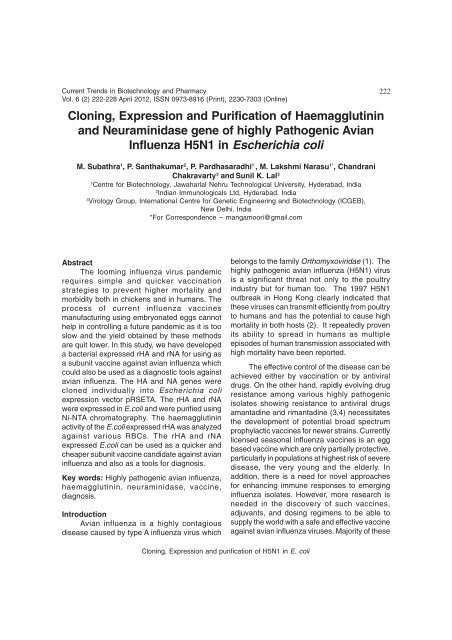d(GC) - Association of Biotechnology and Pharmacy
d(GC) - Association of Biotechnology and Pharmacy
d(GC) - Association of Biotechnology and Pharmacy
Create successful ePaper yourself
Turn your PDF publications into a flip-book with our unique Google optimized e-Paper software.
Current Trends in <strong>Biotechnology</strong> <strong>and</strong> <strong>Pharmacy</strong><br />
Vol. 6 (2) 222-228 April 2012, ISSN 0973-8916 (Print), 2230-7303 (Online)<br />
Cloning, Expression <strong>and</strong> Purification <strong>of</strong> Haemagglutinin<br />
<strong>and</strong> Neuraminidase gene <strong>of</strong> highly Pathogenic Avian<br />
Influenza H5N1 in Escherichia coli<br />
M. Subathra 1 , P. Santhakumar 2 , P. Pardhasaradhi 1 , M. Lakshmi Narasu 1* , Ch<strong>and</strong>rani<br />
Chakravarty 3 <strong>and</strong> Sunil K. Lal 3<br />
1 Centre for <strong>Biotechnology</strong>, Jawaharlal Nehru Technological University, Hyderabad, India<br />
2 Indian Immunologicals Ltd, Hyderabad, India<br />
3 Virology Group, International Centre for Genetic Engineering <strong>and</strong> <strong>Biotechnology</strong> (ICGEB),<br />
New Delhi, India<br />
*For Correspondence – mangamoori@gmail.com<br />
Abstract<br />
The looming influenza virus p<strong>and</strong>emic<br />
requires simple <strong>and</strong> quicker vaccination<br />
strategies to prevent higher mortality <strong>and</strong><br />
morbidity both in chickens <strong>and</strong> in humans. The<br />
process <strong>of</strong> current influenza vaccines<br />
manufacturing using embryonated eggs cannot<br />
help in controlling a future p<strong>and</strong>emic as it is too<br />
slow <strong>and</strong> the yield obtained by these methods<br />
are quit lower. In this study, we have developed<br />
a bacterial expressed rHA <strong>and</strong> rNA for using as<br />
a subunit vaccine against avian influenza which<br />
could also be used as a diagnostic tools against<br />
avian influenza. The HA <strong>and</strong> NA genes were<br />
cloned individually into Escherichia coli<br />
expression vector pRSETA. The rHA <strong>and</strong> rNA<br />
were expressed in E.coli <strong>and</strong> were purified using<br />
Ni-NTA chromatography. The haemagglutinin<br />
activity <strong>of</strong> the E.coli expressed rHA was analyzed<br />
against various RBCs. The rHA <strong>and</strong> rNA<br />
expressed E.coli can be used as a quicker <strong>and</strong><br />
cheaper subunit vaccine c<strong>and</strong>idate against avian<br />
influenza <strong>and</strong> also as a tools for diagnosis.<br />
Key words: Highly pathogenic avian influenza,<br />
haemagglutinin, neuraminidase, vaccine,<br />
diagnosis.<br />
Introduction<br />
Avian influenza is a highly contagious<br />
disease caused by type A influenza virus which<br />
222<br />
belongs to the family Orthomyxoviridae (1). The<br />
highly pathogenic avian influenza (H5N1) virus<br />
is a significant threat not only to the poultry<br />
industry but for human too. The 1997 H5N1<br />
outbreak in Hong Kong clearly indicated that<br />
these viruses can transmit efficiently from poultry<br />
to humans <strong>and</strong> has the potential to cause high<br />
mortality in both hosts (2). It repeatedly proven<br />
its ability to spread in humans as multiple<br />
episodes <strong>of</strong> human transmission associated with<br />
high mortality have been reported.<br />
The effective control <strong>of</strong> the disease can be<br />
achieved either by vaccination or by antiviral<br />
drugs. On the other h<strong>and</strong>, rapidly evolving drug<br />
resistance among various highly pathogenic<br />
isolates showing resistance to antiviral drugs<br />
amantadine <strong>and</strong> rimantadine (3,4) necessitates<br />
the development <strong>of</strong> potential broad spectrum<br />
prophylactic vaccines for newer strains. Currently<br />
licensed seasonal influenza vaccines is an egg<br />
based vaccine which are only partially protective,<br />
particularly in populations at highest risk <strong>of</strong> severe<br />
disease, the very young <strong>and</strong> the elderly. In<br />
addition, there is a need for novel approaches<br />
for enhancing immune responses to emerging<br />
influenza isolates. However, more research is<br />
needed in the discovery <strong>of</strong> such vaccines,<br />
adjuvants, <strong>and</strong> dosing regimens to be able to<br />
supply the world with a safe <strong>and</strong> effective vaccine<br />
against avian influenza viruses. Majority <strong>of</strong> these<br />
Cloning, Expression <strong>and</strong> purification <strong>of</strong> H5N1 in E. coli













